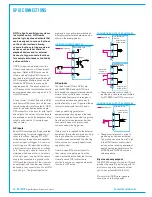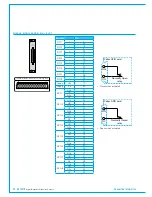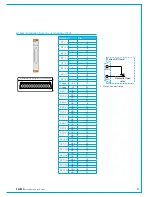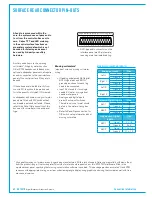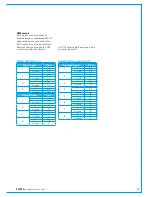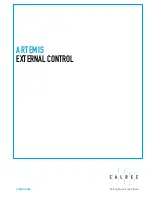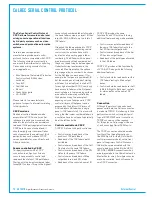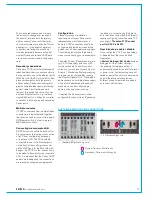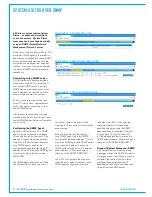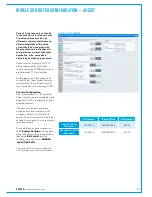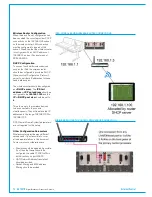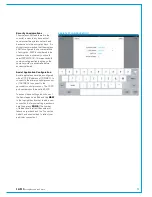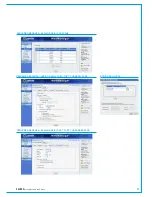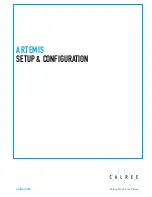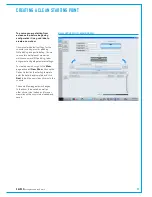
CALREC
Putting Sound in the Picture
69
EMBER REMOTE CONTROL
The EMBER protocol is a
sophisticated data exchange
mechanism that has potential for
controlling many functions across
varied equipment types.
EMBER control has been incorporated
into Calrec’s Apollo, Artemis and Hydra2
range to allow various remote control
functionality, both over mixing consoles,
and the wider Hydra2 network.
Currently, Calrec have tested, and have
users on-air with the following EMBER
controllers:
• L-S-B VSM
• Colledia BNCS
Please refer to the relevant
manufacturer’s guidance for specific
information relating to their products.
Currently, EMBER has the ability to control
the following features when connected to
a Calrec Apollo/Artemis/Hydra2 network:
• Loading of shows and user memories
onto control surfaces.
• Loading / removing alias files used
by consoles, instructing them to use
different pre-defined sets of I/O ports.
• Please refer to the console operator
manual for more information on the use
of alias files.
• Input port settings - mic input gain, mic
input phantom power switching and
SRC switching on digital inputs.
• EMBER controllers can view and edit
the H20 based Hydra2 I/O box and
port labels.
• Inserting SMPTE2020 metadata
into Hydra2 SDI embedder outputs -
Metadata sets can be uploaded and
edited using the H20 application.
EMBER controllers can select any
of the available metadata sets for
insertion to, or removal from any of the
SDI embedder outputs on the network.
• EMBER controllers can selectively
mute any of the audio channels within
the SDI outputs of Hydra2 embedders.
Connectionandredundancy
EMBER clients connect to the front
panel RJ45, labelled 'Ethernet', on
the Main primary router card (slot 2 of
the processing core). Cards fitted in
expansion router slots do not support this
connection.
In multi-console / multi-core networked
systems, the connection should be made
to the Router card in the core configured
as the Master. Slaved router cores do not
support EMBER connections. An EMBER
connection made to the network's Master
Router has access to all of the I/O and
mixing consoles on the Hydra2 network.
In the event of a router failure, the
secondary router card will take over and
continue EMBER communications via the
connection made to the primary card's
front panel. If supported by the 3rd party
controller, a secondary connection can
also be made to the secondary router
card in the same core, providing additional
redundancy against cable, port, and
external third party switch / controller
failure.
If required, other controllers can be
connected to the same RJ45 on the
router at the same time, by using an
external Ethernet switch / hub.
The router card's front panel Ethernet
connector uses a standard Ethernet
pin-out and passes data via TCP/IP.
Screened Cat5e cabling should be used
to ensure performance in electrically noisy
environments.
For 3rd party controllers that pass
EMBER data over RS232/RS422,
serial to TCP/IP conversion is required.
Convertor units, such as the Perle IOLAN
can be supplied by Calrec.
Connectionconfiguration
The 3rd party EMBER controller will need
to be configured to connect using the
IP address of the Calrec Master Router
card (and the secondary if a backup
connection is being made).
In addition to the IP address, the system
will need to be configured to use
TCP
socket port 62000.
The default IP addresses for router cards
are - xxx.yyy.5.0 for a primary and xxx.
yyy.6.0 for a secondary, xxx.yyy is different
for each processing core and can be
confirmed using the Calrec Program
Updater application. If the default IP
addresses are unsatisfactory, Calrec
routers can be configured with alternative
IP addresses of choice. Configuring
alternative IP addresses should only
be done by, or under the guidance of a
Calrec engineer. Please contact your
sales representative, assigned project
leader or customer support to discuss any
alternative addressing requirements.
Note, Calrec default IP addresses are
defined by the core and slot the cards are
fitted in. Alternate, aliased IP addresses
are configured on the cards themselves,
and will therefore follow the card if it is
moved to a different slot or core.
Controlconfigurationandenabling
With a valid connection made, all
parameters accessible to EMBER are
made available. No further Calrec
configuration is required.
Mixing console operators can enable or
disable EMBER controllers from being
able to change their control surface show
/ user memory and I/O aliasing from the
Calrec Main Application's
>System Settings>Ext Control
page.
Содержание Artemis
Страница 5: ...calrec com Putting Sound in the Picture ARTEMIS INFORMATION...
Страница 9: ...calrec com Putting Sound in the Picture ARTEMIS CONTROL SURFACE...
Страница 26: ...26 ARTEMIS Digital Broadcast Production Console...
Страница 27: ...calrec com Putting Sound in the Picture ARTEMIS PROCESSING CORE BEAM SHINE...
Страница 33: ...calrec com Putting Sound in the Picture ARTEMIS PROCESSING CORE LIGHT...
Страница 40: ...40 ARTEMIS Digital Broadcast Production Console...
Страница 41: ...calrec com Putting Sound in the Picture ARTEMIS CONNECTION INFORMATION...
Страница 66: ...66 ARTEMIS Digital Broadcast Production Console...
Страница 67: ...calrec com Putting Sound in the Picture ARTEMIS EXTERNAL CONTROL...
Страница 80: ...80 ARTEMIS Digital Broadcast Production Console...
Страница 81: ...calrec com Putting Sound in the Picture ARTEMIS SETUP CONFIGURATION...
Страница 100: ...100 ARTEMIS Digital Broadcast Production Console...
Страница 101: ...calrec com Putting Sound in the Picture ARTEMIS PANEL OPTIONS...
Страница 110: ...110 ARTEMIS Digital Broadcast Production Console...
Страница 111: ...calrec com Putting Sound in the Picture ARTEMIS OBSOLETE PANELS...
Страница 114: ...114 ARTEMIS Digital Broadcast Production Console...
Страница 115: ...calrec com Putting Sound in the Picture ARTEMIS SPECIFICATIONS...


